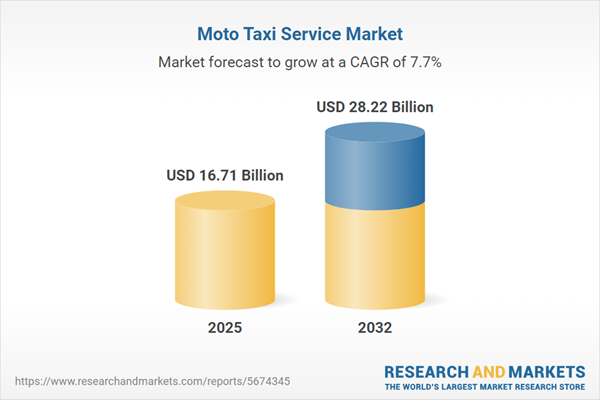Speak directly to the analyst to clarify any post sales queries you may have.
The moto taxi service market is undergoing rapid transformation, shaped by digital integration, evolving mobility trends, and changing regulatory landscapes. Senior decision-makers need timely intelligence to navigate this dynamic sector and align business strategies with shifting urban transportation demands.
Market Snapshot: Moto Taxi Service Market Overview
The global moto taxi service market is set for significant advancement, with value expected to rise from USD 15.58 billion in 2024 to USD 16.71 billion in 2025. Forecasts project the market will reach USD 28.22 billion by 2032, supported by a 7.71% compound annual growth rate (CAGR).
This upward trajectory is fueled by the expansion of digital ride-hailing platforms into both central and developing regions, and ongoing investment in transportation infrastructure. Market leaders are optimizing workflows by leveraging real-time connectivity, streamlining compliance, and adapting quickly to regulatory shifts and evolving rider expectations.Moto Taxi Service Market Scope & Segmentation
- Service Types: On-demand transport, ride-hailing, and ride-sharing services cater to diverse business and commuter needs, delivering flexibility and scalable mobility across multiple use cases.
- Vehicle Types: Three-wheeler and two-wheeler vehicles are commonly used, including auto rickshaws, e-rickshaws, e-scooters, mopeds, and sport bikes. This variety aids operators in compliance and effective navigation through complex urban environments.
- Duration of Usage: Solutions encompass hourly rentals and both short- and long-distance trips, addressing immediate, routine, and enterprise mobility requirements.
- Customer Types: Business travelers, city commuters, and tourists benefit from tailored service offerings that reflect distinct urban travel patterns and support citywide connectivity.
- Applications: Corporate commuting, urban transportation, tourism, leisure trips, and last-mile delivery are major application segments, helping organizations and individuals enhance logistics and mobility efficiency.
- Regional Coverage: The sector serves the Americas, Europe, Middle East & Africa, and Asia-Pacific, reflecting strong growth in developing markets alongside established operations in mature regions.
- Key Companies: Leading operators include Bolt Technology OÜ, DBDOYC Inc., Desto - Bike Taxi, DiDi Global Inc., Dunzo Digital Pvt. Ltd., Felix Coaches, Gojek tech, Grab Holdings Ltd., Limobike Ltd., Metro Africa Xpress, Inc., Motocab, MOTOTAXI LEGAL ATM, Move It, Inc., Opay Digital Services Limited, Pathao Ltd., Roppen Transportation Services Pvt. Ltd., SafeBoda, Uber Technologies Inc., and WunderCar Mobility Solutions GmbH.
Key Takeaways for Senior Decision-Makers
- Adopting digital ride platforms streamlines bookings, builds payment confidence, and elevates real-time tracking for improved managerial control across operations.
- The market’s gradual transition toward electrified vehicle fleets supports sustainability goals, lowering environmental impact while extending asset lifespans and operational efficiency.
- Successful localization strategies—including customized offerings and adaptable subscription models—equip providers to respond effectively to shifting preferences and diverse regulatory requirements in various cities.
- Collaborative partnerships with automakers and logistics partners expand solution offerings, driving innovation for business mobility and urban goods distribution.
- Working closely with municipal authorities enhances the ability to anticipate policy changes and ensures service models are optimized in tandem with urban infrastructure developments.
Tariff Impact on Moto Taxi Service Supply Chains
Recent U.S. automotive tariffs are prompting operators to focus on regional sourcing and expand domestic production processes. By adopting these measures, companies better manage procurement costs, reduce exposure to global supply chain disruptions, and simplify maintenance. Partnerships with local battery suppliers and leveraging government support programs further bolster the market’s resilience. Advances in battery technology are also enhancing service reliability and sustaining operational uptime throughout the provider network.
Methodology & Data Sources
The report draws from primary interviews with leading industry stakeholders—such as fleet managers and regulatory officials—and extensive desk research. Information is cross-validated to ensure accuracy and relevance, meeting the strategic needs of organizational leadership.
Why This Report Matters
- Provides region-specific analysis to optimize fleet allocation, streamline resources, and reinforce supplier relationships as part of evolving urban transport strategies.
- Prepares executive teams to anticipate policy developments, enhance sustainability initiatives, and implement cutting-edge digital solutions throughout the moto taxi service value chain.
- Identifies partnership and expansion opportunities in business travel, last-mile delivery, and logistics, giving leaders the insight needed for long-term competitiveness.
Conclusion
Organizations that embrace innovation and robust localization are best positioned to drive urban mobility success. Strategic flexibility and regulatory alignment will remain essential for navigating continued transformation in this sector.
Additional Product Information:
- Purchase of this report includes 1 year online access with quarterly updates.
- This report can be updated on request. Please contact our Customer Experience team using the Ask a Question widget on our website.
Table of Contents
3. Executive Summary
4. Market Overview
7. Cumulative Impact of Artificial Intelligence 2025
List of Figures
Samples

LOADING...
Companies Mentioned
The key companies profiled in this Moto Taxi Service market report include:- Bolt Technology OÜ
- DBDOYC Inc.
- Desto - Bike Taxi
- DiDi Global Inc.
- Dunzo Digital Pvt. Ltd.
- Felix Coaches
- Gojek tech
- Grab Holdings Ltd.
- Limobike Ltd.
- Metro Africa Xpress, Inc.
- Motocab
- MOTOTAXI LEGAL ATM
- Move It, Inc.
- Opay Digital Services Limited
- Pathao Ltd.
- Roppen Transportation Services Pvt. Ltd.
- SafeBoda
- Uber Technologies Inc.
- WunderCar Mobility Solutions GmbH
Table Information
| Report Attribute | Details |
|---|---|
| No. of Pages | 188 |
| Published | October 2025 |
| Forecast Period | 2025 - 2032 |
| Estimated Market Value ( USD | $ 16.71 Billion |
| Forecasted Market Value ( USD | $ 28.22 Billion |
| Compound Annual Growth Rate | 7.7% |
| Regions Covered | Global |
| No. of Companies Mentioned | 20 |









